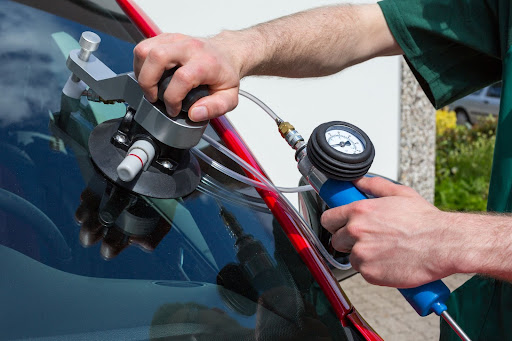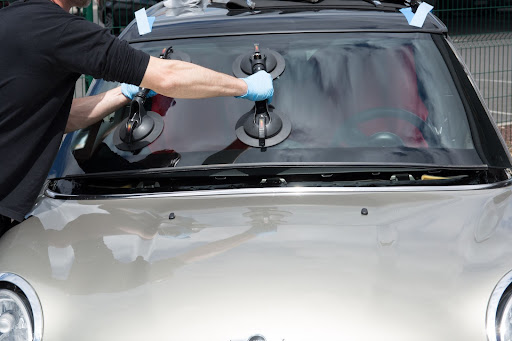
How do you know if it’s time to replace your windshield?
Recognizing the signs that it’s time for a windshield replacement is essential for your safety and the safety of others on the road. In this blog, we’ll explore eight clear indicators that signal when it’s time to replace your windshield, ensuring you stay safe and enjoy a clear view of the road ahead.
Sign 1: Cracks and Chips
Remember those small cracks or chips in your windshield. They may seem insignificant but can lead to more extensive structural damage. Think of them as tiny cracks in a dam; they may start small but can widen over time, weakening your windshield’s integrity. Factors like temperature changes, driving vibrations, and sunlight can accelerate this process.
Why should you care about these minor imperfections? Your safety is at stake. A compromised windshield increases the risk of shattered glass entering your car and undermines your vehicle’s structural support.
In the event of a collision, a damaged windshield may not provide the protection it should. This can lead to more severe injuries and reduce the effectiveness of your airbags and other safety features.
Promptly addressing small cracks and chips is essential to prevent them from becoming larger problems and to ensure your safety and the safety of others on the road.

Sign 2: Extensive Damage
Extensive windshield damage can occur unexpectedly, often in severe weather or accidents. Hailstorms, storms, and temperature fluctuations can all lead to cracks or fractures in your windshield. On the other hand, accidents can exert substantial force on the windshield, causing cracks, chips, or fractures that compromise its integrity.
This damage affects both appearance and functionality. Cracks and shattered glass obstruct visibility, making it challenging to see the road clearly, especially during critical moments requiring quick decisions.
Furthermore, severe windshield damage weakens your vehicle’s structural integrity. It plays a vital role in preventing roof collapse during accidents.
Beyond safety concerns, driving with a severely damaged windshield can lead to legal issues. Many states mandate windshield maintenance, and violations may result in fines or citations. In accidents, your damaged windshield might lead to liability for damages or injuries, affecting insurance claims and fault determination.
So, addressing extensive windshield damage promptly is crucial for safety and to avoid potential legal consequences.
Sign 3: Impaired Visibility
Your windshield is like your window to the world when you’re on the road, and keeping it clean is essential for safe driving. One common issue that can hinder visibility is a dirty or foggy windshield.
Dust, dirt, and grime can accumulate, especially in dusty or polluted areas, obstructing your view. When sunlight or headlights hit these particles, visibility worsens.
Additionally, during certain weather conditions like rain or humidity, fog can form on the inside of your windshield, posing a safety risk.
Reduced visibility due to a dirty or foggy windshield becomes even more perilous in adverse weather, like rain, snow, sleet, or fog. These conditions, combined with compromised visibility, multiply the risks.
Rain can mix with dirt, creating a smeared mess that’s hard to see through. Snow and sleet can accumulate, further limiting your vision. In fog, clear visibility is crucial to spot hazards on the road.
Impaired visibility during adverse weather can also increase stress and anxiety while driving as you struggle to make out road signs, vehicles, and pedestrians.
To ensure your windshield remains clear and your visibility optimal, consider these maintenance tips:
- Regular Cleaning: Clean your windshield both inside and out regularly. Use a good quality glass cleaner and microfiber cloth to remove dirt and smudges effectively.
- Replace Wiper Blades: Worn-out wiper blades can streak and smear, making your windshield even harder to see through. Replace them when they show signs of wear.
- Defogging: Use your car’s defogging or defrosting settings to clear foggy windshields quickly. Ensure your HVAC system is in good working order.
- Rain-Repellent Coating: Consider applying a rain-repellent coating to your windshield. This can help water bead up and roll off the glass, improving visibility in wet conditions.
- Repair Chips and Cracks: Promptly address any chips or cracks to prevent them from growing and obstructing your view.
By taking these steps, you can ensure that your windshield remains clear and your visibility is not compromised, enhancing your safety and peace of mind on the road, especially during adverse weather conditions.
Sign 4: Failed Inspection
Your vehicle’s regular inspection is more than just a formality; it’s a safety check to ensure it meets roadworthy standards. Your windshield’s condition is a critical part of this inspection, and here’s why it matters.
Trained technicians assess various aspects of your vehicle, including the windshield. They look for defects or damage that could hinder visibility or compromise its structural integrity. Significant cracks, chips, or other issues that violate inspection criteria can lead to inspection failure.
Inspections may vary by state, but commonly evaluated windshield aspects include:
- Cracks and Chips: Inspectors check for driver’s line-of-sight obstructions or cracks exceeding a specific size, which can compromise safety.
- Obstructive Damage: Significant damage obstructing the driver’s view, like large cracks, is typically unacceptable.
- Wiper Blade Functionality: Some inspections verify that your wipers effectively clear rain or debris from the windshield.
- Tinting and Stickers: Tinting and sticker placement regulations are also checked to ensure compliance with local laws.
Vehicle inspections exist to uphold road safety standards. Complying with regulations and maintaining a windshield that meets standards enhances safety for you and others on the road.
Driving with a failed windshield inspection isn’t just a safety risk; it can result in fines and impact your ability to renew vehicle registration, rendering your vehicle illegal to operate.
To avoid these consequences and ensure a safe and legal vehicle, promptly address windshield issues to meet local inspection standards. This keeps you law-abiding and contributes to safer roads for everyone.

Sign 5: Age and Wear
Like any vehicle component, windshields aren’t immune to the effects of time and use. They’re typically constructed from laminated safety glass, offering strength and security but still susceptible to aging. Factors like UV radiation, temperature changes, road debris, and pollutants gradually degrade the glass and plastic layers.
Windshield lifespan varies based on factors like vehicle type, driving conditions, and maintenance. On average, they endure for 5 to 15+ years. Even if no visible wear or damage is apparent, degradation can occur over time. This gradual process may be hard to spot without professional inspection, emphasizing the need for regular maintenance and evaluation.
To extend the lifespan of your windshield and ensure it remains in good condition, consider these proactive maintenance tips:
- Regular Cleaning: Regularly clean your windshield inside and out to remove dirt, grime, and contaminants that can accelerate wear.
- Avoid Harsh Chemicals: When cleaning your windshield, use mild, non-abrasive cleaners to prevent scratching the glass or damaging the plastic layer.
- Inspect for Damage: Periodically inspect your windshield for chips, cracks, or other damage. Address any issues promptly to prevent them from worsening.
- Replace Wiper Blades: Worn-out wiper blades can cause scratches and damage to your windshield. Replace them as soon as they show signs of wear.
- Park in Shade: Whenever possible, park your vehicle in the shade to reduce prolonged exposure to UV radiation, which can contribute to aging.
By taking these proactive steps, you can help prolong the life of your windshield, maintain clear visibility, and ensure that it continues to provide the safety and protection you rely on while driving. Remember that regular maintenance extends the life of your windshield and contributes to a safer driving experience.
Sign 6: Noise and Vibrations
Have you ever experienced odd noises or vibrations from your windshield while driving? These seemingly minor sensations can be crucial indicators of windshield damage. Your windshield is a vital part of your vehicle’s structural integrity, and when it’s compromised, it can result in unwelcome sounds and vibrations.
Noise often arises when air enters damaged areas, creating whistling or whooshing sounds. Vibrations may be felt through the steering wheel or the vehicle’s frame. These signals typically suggest an issue with your windshield that shouldn’t be ignored.
Various factors contribute to noise and vibrations from windshield damage:
- Cracks and Chips: Small cracks or chips can create air pockets, generating noise and vibrations, especially at higher speeds.
- Loose Molding or Seals: Damaged seals or molding can allow air to penetrate, causing unwanted noise and vibrations.
- Poor Installation: Improper installation or degraded sealant over time can lead to air leaks, resulting in noise and vibrations.
- Structural Damage: In severe cases, extensive structural damage to the windshield or its surrounding frame can be the root cause of these issues.
While noise and vibrations may seem like minor inconveniences, they can signify potentially serious safety concerns. Ignoring these signs could lead to further windshield damage, compromising its protective role in accidents.
These sensations can affect your driving experience, making it less enjoyable and potentially distracting. Promptly addressing them ensures your safety and enhances overall driving comfort.
To prevent further damage and eliminate these sensations, consult a professional when you notice noise or vibrations from your windshield. They can diagnose the problem and recommend necessary repairs or replacements to restore your windshield’s integrity and your peace of mind on the road.
Sign 7: Safety Features Malfunction
Modern vehicles boast advanced safety features, collectively known as Advanced Driver Assistance Systems (ADAS). These technologies, like lane-keeping assist and automatic emergency braking, enhance road safety.
ADAS systems rely on sensors and cameras often positioned near your windshield. Damaged windshields can hinder these vital safety features in several ways:
- Sensor Obstruction: Cracks or chips block sensors, hindering obstacle detection.
- Misalignment: Windshield damage can misalign sensors, leading to inaccurate readings and false alerts.
- Calibration: Windshield repairs or replacements may require ADAS recalibration to ensure proper function. Neglecting this can lead to malfunctioning safety features.
The consequences of impaired ADAS systems are serious. Compromised ADAS diminishes your ability to react to road dangers. Damaged sensors may trigger unwarranted alarms, causing panic or distraction. Safety technologies can inadvertently compromise safety when impaired, potentially leading to preventable accidents.
Promptly address windshield damage to ensure safety and maintain ADAS effectiveness. Choose a reputable service provider capable of ADAS recalibration during windshield repair or replacement. This way, you can continue enjoying the full benefits of these life-saving technologies while driving.
Sign 8: Discoloration and Hazing
Over time, your windshield may show signs of discoloration and hazing due to prolonged exposure to environmental elements and contaminants. Discoloration is a yellow or brownish tint, often from UV rays breaking down glass materials. Hazing results in a cloudy or foggy film due to dirt, pollutants, and cleaning residue.
While these issues may seem cosmetic, they significantly impact safety and aesthetics:
- Reduced Visibility: Discoloration and hazing impair visibility, especially in bright sunlight or at night, raising accident risks.
- Glare: Discoloration creates glare, making it harder to see road elements, like traffic signals.
- Aesthetic Concerns: These problems diminish your vehicle’s appearance and potentially affect resale value.
To address these issues:
- Regular Cleaning: Use automotive glass cleaner to clean your windshield frequently, avoiding abrasive chemicals.
- Professional Polishing: For persistent hazing or discoloration, consider professional windshield polishing or restoration services to restore clarity.
- Preventive Measures: To prevent discoloration, use UV-blocking windshield film or park in the shade. Regular cleaning can also prevent hazing.
- Replacement: When issues are severe, windshield replacement ensures clear visibility and safety.
Promptly addressing discoloration and hazing using these suggestions enhances your driving experience and road safety.

Let Valley Glass Safely Repair or Replace Your Windshield
When it comes to windshield replacement, trust the experts at Valley Glass. We understand your windshield’s critical role in your safety on the road, and we’re committed to providing top-notch service. With a history of excellence in glass replacement and repair, we offer the personal attention and expertise that sets us apart.
Whether you need a new windshield, exterior door installation, or auto glass repair, Valley Glass is here to ensure your project is handled with precision and professionalism. Your safety and satisfaction are our priorities, so don’t hesitate to reach out to us for all your glass replacement needs.



Leave a Reply